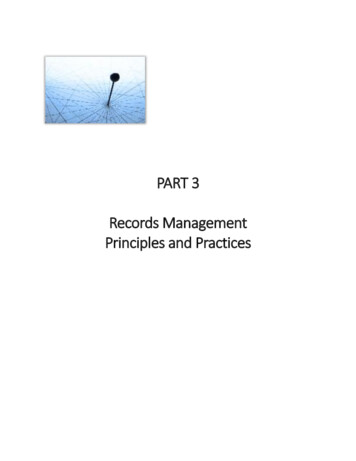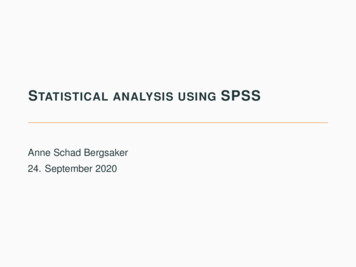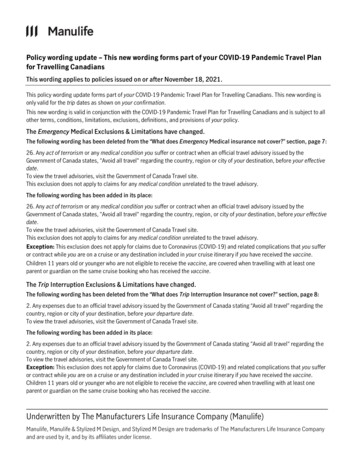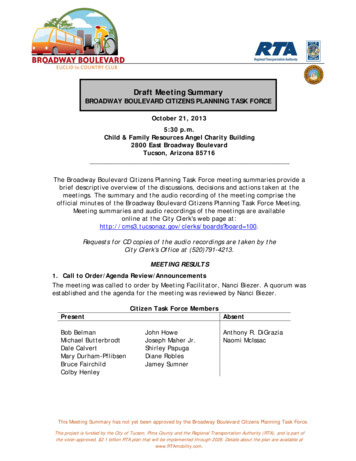
Transcription
What You Need to Knowto Avoid Identity Theft
Table of ContentsIntroduction3What is Identity Theft?4Important Identity Theft Facts6Types of Identity TheftFinancial Identity TheftCriminal/Impersonation Identity TheftChild Identity Theft78910How Thieves Steal Your IdentityOnlineOfflineOther Methods11121415How Identity Theft Affects You16How You Can Protect YourselfGeneral TipsOnlineOffline19202122What to Do if You Become a Victim23Resources: Additional Information24About McAfee25
IntroductionWhen you think of theft, you usually think of someone stealingyour possessions. To avoid theft, you may have taken the troubleto install an alarm system in your home or lock up your valuablesin a safe or a safety deposit box at the bank. But nowadays,possessions aren’t the only things you need to protect. Modernthieves have gone high-tech—they can take your money, useyour credit, and ruin your reputation by stealing your identity.Identity theft can happen to anyone because all of our personalinformation is scattered in so many places—from online shoppingwebsites and corporate databases to wallets and scraps of paper.In this guide, you will learn more about how identity theft occursand the measures you can take to protect yourself.3
What is Identity Theft?Identity theft, or identity fraud, occurs whensomeone steals information that defines yourpersonal identity—such as your name, driver’slicense number, passport number, bank accountnumbers, and credit card numbers—to reapthe benefits of posing as you. These benefitscan be financial, such as access to your accountsand credit cards, or they can be reputationalin that thieves can use your identity to get a jobor commit a crime.
Using your personal details, a thief can open a credit card account and run upcharges, create counterfeit checks using your account number, or even obtainan official document, such as a driver’s license or passport, in your name.When this happens, you not only lose money, you also face losing the ability totake out a loan, or get a job due to bad credit and a damaged reputation. In severecases, you could even be placed in jail for mistaken identity.Most often, it takes a long time for victims to realise that their identities have beenstolen, and by the time they become aware of the fraud the thief is long gone. Thisexplains why it’s so easy for thieves to commit identity theft and why it’s so hard forlaw enforcement to catch them.FACT:Every three seconds, an identityis stolen.11Identity Theft Protection site, ntity-theft-statistics/5
Important Identity Theft Facts The Home Office of the United Kingdom calculated the cost of identity theftto the British economy at 2.1 billion during the last three years 2 In the UK the most common form of identity theft information gathering occursthrough the use of spyware3 Credit card fraud losses in 2009 in the United Kingdom totaled 440.3 million4 There were more than 51,000 phishing incidents recorded during 2009—a 16% increase on the amount seen in 2008 5 From 2005 to 2009, there have been more than 500 million consumerswhose personal and financial data had been exposed as a result of corporatedata breaches—events the victim cannot control despite taking personalsafety measures6 Victims spend an average of 58 hours repairing the damage done to existingaccounts and an average of 165 hours repairing damage done by the creationof new, fraudulent accounts7 43% of identity theft occurs from a stolen wallet, checkbook, credit card, billingstatement, or other physical ity-theft-around-the-world.htmlIbid4UK Cards Association - e/press releases ty Theft Research Center. Identity Theft: The Aftermath 20088Ibid76
Types of Identity TheftWhen most people think of identity theft theythink of stolen credit cards or banking information,but there are actually various kinds of identity theftthat can affect other important areas of your life,such as your finances, your reputation, and yourchild’s credit record.Let’s take a look at the different kinds of identitytheft so you can gain a better understanding of whatyou need to do to protect you and your family.
Financial Identity TheftFinancial identity theft involves using stolen personal information to get accessto your money or credit. This is the most common type of identity theft becauseit is lucrative and often hard to trace. Problems resulting from financial identitytheft include: Unauthorised credit card charges—Thieves who steal your credit cardor misdirect billing statements to get ahold of your information can essentiallytake over your credit card account to make fraudulent charges. Criminals canalso gain access to your account by intercepting new credit cards sent throughthe post or by applying for a new card with your personal information. When thethief fails to pay the charges they run up on your card, this can affect your credit,especially if it takes a while to figure out that your information has been stolen. Bad credit—If a thief uses your personal information to obtain loans, goods,and services and doesn’t pay the bills, this can damage your credit.8
Criminal/Impersonation Identity TheftCriminal identity theft, or criminal impersonation, is when a thief takes over youridentity and assumes it as their own. The thief could give your driver’s license, dateof birth, or passport number to law enforcement officers during an investigationor upon arrest. Alternatively, the imposter could present a counterfeit licensecontaining your data.Dangers of criminal identity theft include: Criminal records—If an identity thief commits a crime and presents himselfto authorities using your name, then you could wind up with a criminal recordor warrants for your arrest. You could even end up spending time in jail. Traffic violations or warrants in your name—If a thief steals your driver’slicense and commits traffic violations, they could present your identification tolaw enforcement officials. When they fail to pay the tickets or go to traffic court,you could be left with hefty fees and even warrants for your arrest.9
Child Identity TheftThere is a growing trend among identity thieves to steal the identities of children,even infants, since a child’s records represent a clean slate for the criminal andit usually takes years before the theft is discovered. Often, the first time victimsdiscovers that their identity was stolen is when they engage in their first financialtransaction and try to establish credit by, for example, purchasing a cell phoneor buying a car.The dangers of child identity theft include: Damaged credit—If many years pass before the victim realises that their identityhas been stolen, a long history of poor credit that is difficult to unravel may bethe result. Income tax liability—If the thief has been working using a child’s stolenidentity, the child could be held liable for income taxes.FACT:The Identity Theft Resource Centerreports that more than half (54%) ofthese crimes were committed againstchildren under six years old.99Federal Trade Commission, About Identity Theft microsite10
How Thieves StealYour IdentityIdentity theft is a growing problem. With that inmind, it’s worth knowing how thieves can steal youridentity. Unfortunately, they have numerous tricksup their sleeves—from old-fashioned methods suchas stealing your wallet and raiding your mailboxto high-tech methods, such as data breaches andemail scams.Let’s review some of the most common ways crookscan steal your sensitive information so that you cantake preventative measures.
Online Phishing—Phishing scams are spam emails sent by cybercriminals that pretendto be from a legitimate person or organisation with the intent of tricking youinto revealing personal information. For instance, a cybercriminal may sendan email that looks like it originates from your bank asking you to “confirm”account information by clicking on a link that takes you to a fake website andasks you to type in your bank account user name and password. Phishing is oneof the most common types of cybercrime, and thieves are constantly updatingand changing their scams in hopes of fooling you. Pharming—In a pharming attempt, a hacker installs malicious code on yourpersonal computer to direct you to fake websites without your knowledge.You could be directed to a fraudulent shopping site where you might enter yourpayment information without knowing that the site is not legitimate. Spim—Spim is spam sent via instant messaging (IM). The IMs could includespyware, keyloggers, viruses, and links to phishing sites. Spyware—This is software that a hacker surreptitiously installs on your computerto collect personal information. It can also be used to direct you to fake websites,change your settings, or take control of your computer in other ways.12
Keyloggers—A keylogger is a form of spyware that records keystrokes as youtype. The information you type is then saved to a file that the hacker can access.If you are surfing the web and visiting banking and e-commerce sites, a keyloggercan potentially record your account and password information, which the hackercould then use to get access to your credit card or banking accounts and evensteal your identity. Trojan horse—A Trojan horse is a malicious program that appears to be harmless.If you unwittingly download a Trojan horse from the web, it could allow the hackerremote access to your machine from anywhere in the world, which gives them theability to access files on your computer and even watch your screen activity. Social networking sites—With so much popularity surrounding social networkingsites, it’s sometimes easy to forget that people outside your circle of friends canoften access the information you post about yourself. By providing details suchas your name, date of birth, contact details, and employer, thieves can start topiece together the information they need to steal your identity. Wardriving—Thieves also try to steal your personal information using atechnique called wardriving, where they drive around looking for unsecured wirelessconnections (networks). If your home wireless connection is not secured, hackerscan access data on all the computers you have connected to your wireless router,as well as see information you type into your banking and credit card sites.FACT:Theft of personal identifiableinformation from Internet scamsis at an all time high.1010Federal Trade Commission, About Identity Theft microsite13
OfflineFACT:In 42% of identity theft cases, victimsreported that the imposter was a friend,family member, ex-spouse/partner, orsomeone in close contact with themsuch as a coworker.11 Mailbox raiding—Thieves look to raid unlocked mailboxes. They are onthe lookout for credit card, bank, and other financial statements which usuallyinclude account numbers. They also look for pre-approved credit card applicationsso they can open a new account in your name without your knowledge. Dumpster diving—In urban areas, crooks turn to a similar method: theydig through your rubbish looking for financial documents and papers that includesensitive information. Thieves can use the booty they find through mailbox raidingor dumpster diving to change your address and divert your billing statementsin an effort to conceal the fact that your identity has been stolen. Stealing wallets/checkbooks—Wallet and checkbook theft may be theoldest trick in the book, but that’s because it works. Many carry around not onlytheir driver’s license, but also their identification card, credit cards, and automatedteller machine (ATM) cards, giving thieves all the information they need toimpersonate their victims. Stealing information from homes—We tend to leave our bills and sensitivedocuments lying around the house and forget that family, visitors, at-homeemployees, and contractors can then easily access this information. Address fraud—A criminal can also easily change your address and redirectyour mail to a different address so they can steal your confidential informationor take over your banking or credit card accounts. Shoulder surfing—A criminal can get access to your pin number or passwordby simply watching over your shoulder as you are using an ATM or typing on yourcomputer. Or they could be listening as you provide your credit card number oridentification information over the phone to a legitimate vendor. Either way, theynow have your data in hand and can commit serious crimes.11Federal Trade Commission, About Identity Theft microsite14
Other Methods Vishing/smishing—Vishing and smishing are the same as phishing,except that vishing is done by telephone, and smishing is done by text message,although both often include an email component.In a vishing attempt, a scammer may call you pretending to be from your bankto inform you that they have noticed some suspicious activity on your account.They would then ask you to “verify” account details over the phone.In a smishing attempt, a scammer may send a link to a malicious website or aphone number that has an automated voice response system (a type of vishing)that asks for your personal information. Skimming—When you insert your ATM card into a compromised machineor run your credit card through a phony card reader, you could become a victimof skimming. Skimming is where a hacker illegally obtains information from themagnetic strip on the back of your credit or ATM card. This information can thenbe used to access your accounts or produce a fake credit card with your nameand details on it. Corporate data breaches—Corporations of all sizes, whether they arehealthcare providers, insurance companies, or online businesses, store a largeamount of sensitive customer information. If this information is hacked orleaked, your personal and financial details may be exposed.FACT:ATM skimming costs consumersand companies more than 8.5 billiona imming15
How Identity TheftAffects YouUnlike the theft of a watch or stereo, identitytheft can result in serious consequences that takeboth time and money to resolve, not to mentionthe emotional distress you may feel. Here areways in which identity theft can affect your lifeand your future.
Financial LossOf course, the most obvious loss is financial. If the thief has access to yourchecking, savings, or investment accounts, they can steal funds from your account.Damaged CreditBecause identity thieves open fake accounts at billing addresses that are differentfrom yours, it’s easy for them to run up charges without your knowledge. If thesecharges go unpaid, the delinquent accounts can show up on your credit report.You may not even realise that your credit has been damaged until you try to takeout a car loan or mortgage and are denied credit.Credit damage is particularly dangerous when it happens to children with stolenidentities because it could be years before they attempt their first financial transactionand realise that their credit has been ruined.Loss of BenefitsIdentity thieves are often interested in other information beyond bank accountnumbers, such as your date of birth, address and passport number. Once they getahold of these details, they can potentially obtain a driver’s license in your name,receive benefits, and even land a job impersonating you.17
Criminal RecordIt may seem farfetched, but if a thief steals your identity and uses it to commit acrime, you could get a criminal record. A crook could obtain an identification cardwith your information and when that crook is arrested for a crime, the chargesgo on your record. And if the crook skips bail or doesn’t appear before court, it’sno loss to him because the authorities have a warrant out for you. The worse partis that you may not even know that you have a criminal record until you are pulledover for a traffic violation and arrested or when you apply for a job and are turneddown after a background check.The Cost to Repair DamageBecause it often takes a long time to realise that you’ve become a victim ofidentity theft, the damage can mount. Before you know it, you might be facingmultiple fraudulent charges, damage to your credit report, and other issues thattake considerable work and expense to repair. You can end up spending hourson the phone dealing with corporate and government bureaucracies trying to clearyour name, and you may even decide to hire a credit repair service to help you.Even then, it may be years before you actually are able to clear the damage doneto your reputation.FACT:70% of victims have trouble gettingrid of or are unable to delete negativeinformation in their stics.html18
How You Can Protect Yourself
General Tips Awareness and education—Knowledge of the tricks and scams that thievesuse to try to obtain your personal information can go a long way towardpreventing identity theft. Be vigilant about sharing your personal details, andtry to stay up to date on the latest scams. Common sense—Keep personal data private. When a person, website, or emailasks for your personal information, ask yourself if it is standard practice for suchinformation to be requested. Common sense will tell you that your bank wouldnever send you an email asking you to confirm your account number, user nameand password or ask for details like your passport or driver’s license number. Be aware of those around you—Be mindful of your environment and otherswho may be in proximity when you make purchases over the phone, type inyour ATM PIN, enter your credit card while shopping online, or text personalinformation. And remember to never send your credit card or account numbersto anyone via email.20
Online Online protection—When you are surfing the web, use a comprehensivesecurity suite, such as McAfee Total Protection software, which not only protectsyou against viruses, spyware, and other emerging threats, but also provides safesearch technology to help you steer clear of fake websites that try to collectyour information.In addition, make sure you use a firewall to block unauthorised access to yourcomputer or network. Use strong passwords—Passwords should be at least 10 characters longand should consist of a combination of letters, numbers, and special characters.Also, consider changing your passwords periodically to reduce the likelihood thatthieves can appropriate them and misuse them. Do not share passwords withanyone—not even with friends and family. Practice safe surfing on public hotspots—If you are using a publiccomputer or accessing the Internet from a public hotspot or an unsecuredwireless connection, do not log in to banking and credit card sites. Do yoursurfing at home on a secure network. Secure your wireless network—To prevent wardriving, enable the firewallon your router and change the administrator’s password. Most routers comewith a default user name and password, allowing you to set up and configurethe router, but hackers are often familiar with these defaults. You may alsowant to change the default identifier on your router that is used to announce itspresence to devices in the immediate area and permit access only from computersor devices you designate. Check your router’s user manual to find out how tochange these default settings.21
Offline Review your financial statements promptly—Check your credit cardand bank statements each month to make sure there are no fraudulent chargesand to confirm that you authorised all transactions. Shred documents—The only way to keep thieves from digging up yourpersonal information from the rubbish is to shred sensitive documents, suchas financial statements, credit card offers, and expired driver’s licenses. Get a locked mailbox—If you live in a residence with communal area for postget a mailbox that only you can access. Keep your documents safe—Put personal documents in a lockable drawer,safe, or cabinet at home, and consider storing valuable financial documents suchas stock certificates at your bank. Monitor credit history—Because it can take a long time to discover that you’vebecome a victim of identity theft, you should monitor your credit history to see ifthere are accounts or delinquent payments of which you may be unaware. Thereare a number of websites that offer free access to your credit reports, as well aspaid services that monitor your credit for you. Use a protection service—Identity protection services help safeguard youridentity by monitoring your credit, as well as providing proactive protection,such as sending notifications when new accounts are opened in your name.These services are usually provided for a monthly fee that includes free accessto your credit reports.22
What to Do if You Become a VictimIf you discover that your identity has been compromised or stolen, take immediate steps to addressthe situation.1. Notify the credit bureaus and create a fraud alertCall the fraud department of the credit bureaus and notifythem of the situation. They can set up fraud alerts onyour account that will require creditors to call you beforeextending credit.2. File a police reportIf you know your identity has been stolen, file an identitytheft report with your local police department, whichmaintains a list of fraudulent accounts. Keep a copy ofthe report so you can give the number of your investigatorto creditors and others who may ask you to verify thatyour identity has been stolen.3. Contact financial institutions and agencies whereyour accounts may be affectedCall your bank and creditors to inform them of the situationand flag any fraudulent charges or withdrawals from youraccounts and then follow up in writing. Verify that the chargeshave been removed from your accounts, and if necessaryclose the account. Keep copies, document conversations,and maintain records related to the theft.4. Put a credit freeze in placeYou can block thieves from opening new accounts in yourname by freezing or locking access to your credit file at thethree credit bureaus. If a thief tries to open a new account,he will be denied credit because the potential creditor orservice provider will not be able to check your credit file.5. Consider legal help or an identity restoration specialistIf you feel overwhelmed by the extent of the damage, youmay want to consider hiring legal counsel to help you dealwith debt collectors, credit bureaus, and creditors. Identityrestoration specialists can also help guide you through fixingthe problem. For instance, you can call the McAfee CybercrimeResponse Unit for free advice on what to do in the case ofidentity theft.23
Resources: Additional InformationBelow are some sites that can help you understand more about identity theft and fraudand how to protect yourself.Identity Theft InformationGovernment AgenciesIdentity Theft Resource Centerhttp://www.idtheftcenter.org/National Fraud Reporting Centrehttp://www.actionfraud.org.uk/Identity Theft Assistance iew.php?cateid 19To report fraud: 0300 123 2040Home Office Identity Fraud Steering Committeehttp://www.identitytheft.org.ukRoyal Mailhttp://www.royalmail.comAbout Identity Thefthttp://www.aboutidentitytheft.co.uk/Customer Enquiry Number: 08457 740740McAfee Cybercrime Response ardwatch.org.uk/Report PhishingCIFAShttp://www.cifas.org.ukIdentity & Passport Service (IPS)To report lost or stolen .htmNational Fraud es/default.aspxAnti-Phishing Working Groupreportphishing@antiphishing.orgBank Safe Onlinereports@banksafeonline.org.ukFraudwatch Internationalscams@fraudwatchinternational.com24
For more information and advice about PC and Internetsecurity, please visit the McAfee Security Advice Centerat home.mcafee.com/AdviceCenter/Default.aspxAbout McAfeeMcAfee, Inc., headquartered in Santa Clara, California,is the world’s largest dedicated security technology company.McAfee is committed to relentlessly tackling the world’stoughest security challenges. The company delivers proactiveand proven solutions and services that help secure systemsand networks around the world, allowing users to safelyconnect to the Internet, browse and shop the web moresecurely. Backed by an award-winning research team,McAfee creates innovative products that empower homeusers, businesses, the public sector and service providersby enabling them to prove compliance with regulations,protect data, prevent disruptions, identify vulnerabilities,and continuously monitor and improve their security.http://www.mcafee.comMcAfee, Inc. 3965 Freedom Circle, Santa Clara, CA 95054 1.866.622.3911 www.mcafee.comThe information in this document is provided only for educational purposes and for the convenienceof McAfee customers. The information contained herein is subject to change without notice, and isprovided “AS IS” without guarantee or warranty as to the accuracy or applicability of the informationto any specific situation or circumstance.McAfee, the McAfee logo, and McAfee Total Protection are registered trademarks or trademarks ofMcAfee, Inc. or its subsidiaries in the United States and other countries. Other marks and brands maybe claimed as the property of others. The product plans, specifications and descriptions herein areprovided for information only and subject to change without notice, and are provided without warrantyof any kind, express or implied. Copyright 2010 McAfee, Inc.665gde identity-theft 0410
6 Important Identity Theft Facts The Home Office of the United Kingdom calculated the cost of identity theft to the British economy at 2.1 billion during the last three years2 In the UK the most common form of identity theft information gathering occurs through the use of spyware3 4 Credit card fraud losses in 2009 in the United Kingdom totaled 440.3 million











